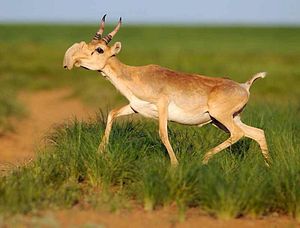In what seems like an eerily, almost-annual event, 1000 saiga antelope have been found dead on the Kazakh steppe that is one of the critically endangered species’ last refuges in the wild.
A day after reports that 100 of the strange ungulates were found dead, RFE/RL reports that the Kazakh Deputy Agriculture Minister Erlan Nysanbaev raised the total to over 1000 in a briefing May 13. The animals, which the WWF classifies as ‘critically endangered’ (one step above ‘extinct in the wild’), are native to the Eurasian steppe and once roamed from the foothills of the Carpathian Mountains (in modern Romania) all the way to Mongolia.
Hunted to extinction in Europe before the end of the 18th century, there are now fewer than 250,000 left, living mostly in Kazakhstan. The latest die-off occurred in the Amangeldi district of the Kostanay region in Kazakhstan.
Nysanbaev said “it is most likely that the mass saiga event has been caused by the pasteurellosis infection, but a clear answer can only be given once test results are ready.”
But this is not the first time saiga antelope have been found dead–of mysterious causes, disease or simply by the hands of poachers. In the summer of 2014, dozens of antelopes were found dead in the Akmola region, which is to the immediate east of Kostanay. At the time authorities said a dozen had no visible cause of death, but more than 70 had been shot, their horns sawed off. That summer Chinese customs at the Kazakh border reportedly discovered 66 cases filled with over 2,000 saiga antelope horns. Saiga antelope horns are used in traditional Chinese medicine and are worth thousands of dollars on the black market.
Poachers may not be the only threat. Due south of Kostanany region is the Baikonur Cosmodrome, a Soviet-built space launch facility from which Sputnik was launched. The cosmodrome is still operated by Russia, which uses the facility for all of its manned missions. After the shuttering of the U.S. space shuttle program in 2011, Baikonur became the only launching site for manned missions to the International Space Station (ISS)
In 2012, 1000 saiga antelopes were found dead in northern Kostanay less than two months after an ISS mission returned to earth. Scientific American wrote at the time “this is getting a bit weird.” Kazakh authorities said then that pasteurellosis was the cause, but offered no evidence. Meanwhile, a pattern of sorts was emerging. In 2011, over 400 Saiga antelopes were found dead on the steppe. The cause was attributed by West Kazakhstan Region Governor Baktykozha Izmukhambetov as “some sort of poisoning from the flora, which is to say from the grass, is taking place.”
RFE/RL says that some Kazakh environmental activists “continue to insist Russia’s space program is at fault and have demanded that the government end launches at the Soviet-built Baikonur Cosmodrome, in central Kazakhstan, of Russia’s Proton-M carrier rockets.” The Proton-M rockets have highly toxic fuel and more than a few rockets have exploded over the Kazakh steppe over the more than 50 years the facility has been in operation.
In 2010, 15 percent of the total population died of mysterious causes–12,000 dead antelopes in the Zhanybek district of the West Kazakhstan region. Again, pasteurellosis was the stated cause. A press release from the Saiga Conservation Alliance noted that “Pasteurellosis is caused by a bacterium that lives naturally in healthy individuals, but can cause acute illness and rapid death if the animal’s immune system is compromised, either by another infection, poisoning, stress or malnutrition. Any of these explanations is still currently possible.”
It will be difficult to ascertain the objective cause of these repeated saiga mass death events. Ecosystems are fragile and complex, and more than likely a combination of factors contributes to the deaths of these strange creatures.
































